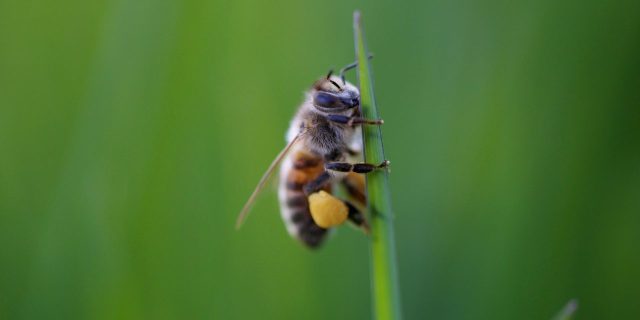26
Apr
Organic Beekeeping Able to Manage Bees As or More Successfully than Chemical-Intensive Approach

(Beyond Pesticides, April 26, 2023) Organic methods of honey bee management are just as or more effective than conventional, chemical-intensive management systems, according to research published this month in the journal Scientific Reports by a team of Penn State scientists. This finding is important as managed pollinators continue to be under stress primarily from pesticide exposure, but also other factors, such as disease, pests, climate change, and habitat loss. In this context, beekeeping management practices can mean the difference between a colony thriving, surviving, or declining.
“Beekeeping management is a key aspect of honey bee health because it can help mitigate some of the negative effects caused by these stressors,” said study co-author Robyn Underwood, PhD, of Penn State Extension. “For example, supplemental feeding can mitigate a lack of flowering plants nearby for foraging, and beekeepers can manage pests such as Varroa mites with cultural, mechanical and chemical control practices.”
Scientists developed protocols to test different beekeeping management systems through participatory science. Thirty beekeepers were invited to work with scientists using protocols on experimental design, applying three different management approaches: i) conventional chemical; ii) organic; and iii) management without inputs. “We wanted to replicate what beekeepers were doing in their bee yards,” study coauthor Margarita LĂłpez-Uribe, PhD, said. “It wasn’t scientists just telling beekeepers how to do things—it was beekeepers telling us how they do things, and then we collected data over multiple years comparing the different systems.”
The experiment worked with eight certified organic farms in the Pennsylvania and West Virginia region, establishing 288 different colonies, with each farm housing 36 colonies. All colonies were established from packaged bees. Scientists worked to homogenize the genetic background of the colonies by requeening all colonies with grafted sister queens from a colony located near Utica, NY that had not received varroa treatments for seven years or more.
Management approaches differed based on the approach. Conventionally managed colonies had screened bottom boards, and were treated each fall with the miticide Apivar, containing the conventional chemical amitraz. They were given candy boards over winter in January.
Organic colonies contained solid bottom boards, and were treated with a rotation of organic-approved materials. Combs designed specifically to rear drones (and subsequently be removed to address Varroa) were employed, and over winter rations included granulated sucrose provided in January.
Colonies without inputs utilized a smaller cell foundation than the other two colonies (4.9mm vs 5.4 mm), used solid bottom boards, a cotton cloth inner cover, and were not treated for mites or given over winter food unless there was evidence of hive starvation.
Colonies were inspected every two weeks in 2018 and 2019, and every three weeks in 2020 due to the pandemic. Pests and pathogens were counted in October of each year, screening for a range of honey bee diseases. Scientists also looked at gene biomarkers corresponding to honey bee health.
Beekeeping methods without inputs were unable to maintain strong colonies over the course of the experiment. Out of the 96 colonies assigned to each management system, only 1 single colony remained by the end of the study. While conventional chemically managed colonies had 29 survive, the organic system enabled the greatest survival, with 38 colonies at the end of the experiment.
In addition to survival, organic and conventional methods provided for more total honey production than the no-input system. Both organic and conventional systems also adequately addressed pests and diseases. Mites were found in 92% of hives, and organic was able to effectively match chemical management in reductions – by 72% in organic to 78% in conventional, relative to the chemical-free system. Chemical-free colonies consistently had the highest level of varroa, averaging 4.5 mites per 100 bees. This trend held with other diseases, such as deformed wing virus and Nosema. Despite the overall success of systems that treated bees, input-free management did result in higher gene expressions corresponding to honey bee health. Â
In sum, given the similarities in outcomes between conventional chemical and organic approaches to beekeeping, the authors conclude that organic represents an effective, sustainable method that improves colony health. “Taken altogether, these results suggest that not only is the organic system suitable for a sustainable beekeeping industry but that the use of threshold-based criteria for the application of organic miticides can have positive effects on colony health,” the study reads.
The failure of input-free system appears to be a result of heavy pest pressure experienced with beekeeping in the modern era, and it is evident that more research and development is needed to adequately manage the scourge of varroa with completely non-pesticidal interventions. Â
Despite the success of organic methods, beekeepers utilizing these techniques are unable to label their honey as organic certified. Organic certified honey, under current USDA regulations, must be able to maintain a guaranteed 3km (1.8 mile) radius around colonies where no pesticide spray is used. Currently, this is only possible in remote locations, and why many organic consumers can only find certified organic honey from foreign countries like Brazil. “Our future research about the landscape and foraging should help us to inform changes in the standards for certification to decrease the required radius of ‘clean’ forage, assuming our hypotheses are supported,” said Dr. Underwood. For more information on organic beekeeping methods, see Penn State’s publication “An Organic Management System for Honey Bees.”
With honey bees and other pollinators under constant stress from pesticides, parasites, pathogens, climate change, and habitat destruction, it is critical that we all take what actions we can to protect these critical species. See Beyond Pesticides recent Earth Day 2023 post for activities you can take to proactively benefit pollinators and other wildlife.
All unattributed positions and opinions in this piece are those of Beyond Pesticides.
Source:Penn State, Scientific Reports










